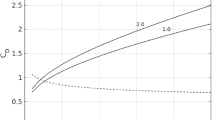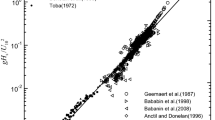Abstract
Depending on the choice of reference wind speed, the quantitative and qualitative properties of the drag coefficient may vary. On the ocean surface, surface waves are the physical roughness at the air-sea interface, and they play an important role in controlling the air-sea exchange processes. The degree of dynamic influence of surface waves scales with wavelength. Drag coefficient computed with the reference wind speed at an elevation proportional to the wavelength (for example, U λ/2) is fundamentally different from the drag coefficient computed with the wind speed at fixed 10 m elevation (U 10). A comparison has been carried out to quantify the difference in wind stress computation using several different parameterization functions of the drag coefficient. The result indicates that the wind stress computed from U 10 input using a drag coefficient referenced to U λ/2 is more accurate than that computed with drag coefficient functions referenced to U 10.
Similar content being viewed by others
References
Anctil, F. and M. A. Donelan (1996): Air-water momentum flux observed over shoaling waves. J. Phys. Oceanogr., 26, 1344–1353.
Banner, M. L., W. Chen, E. J. Walsh, J. B. Jensen and S. Lee (1999): The Southern Ocean Waves Experiment. Part I: Overview and mean results. J. Phys. Oceanogr., 29, 2130–2145.
Dobson, F. W., S. D. Smith and R. J. Anderson (1994): Measuring the relationship between wind stress and sea state in the open ocean in the presence of swell. Atmos.-Oceans, 32, 237–256.
Donelan, M. A. (1979): On the fraction of wind momentum retained by waves. p. 141–159. In Marine Forecasting, ed. by J. C. J. Nihoul, Elsevier.
Donelan, M. A. (1990): Air-sea interaction. p. 239–292. In The Sea—Volume 9: Ocean Engineering Science, ed. by B. LeMehaute and D. M. Hanes, Wiley Interscience.
Donelan, M. A., F. W. Dobson, S. D. Smith and R. J. Anderson (1993): On the dependence of sea surface roughness on wave development. J. Phys. Oceanogr., 23, 2143–2149.
Garratt, J. R. (1977): Review of drag coefficients over oceans and continents. Mon. Wea. Rev., 105, 915–929.
Geernaert, G. L. (ed.) (1999): Air-Sea Exchange: Physics, Chemistry and Dynamics. Kluwer Academic Publ., Dordrecht, The Netherlands, 578 pp.
Geernaert, G. L. and W. J. Plant (eds.) (1990): Surface Waves and Fluxes, I and II. Kluwer Academic Publ., Dordrecht, The Netherlands, 372 and 336 pp.
Geernaert, G. L., S. E. Larsen and F. Hansen (1987): Measurements of the wind stress, heat flux, and turbulence intensity during storm conditions over the North Sea. J. Geophys. Res., 92, 13127–13139.
Huang, N. E. (1999): A review of coastal wave modeling: the physical and mathematical problems. p. 1–20. In Advances in Coastal and Ocean Engineering, 4, ed. by P. L.-F. Liu, World Scientific, Singapore.
Hwang, P. A. (2004): Influence of wavelength on the parameterization of drag coefficient and surface roughness. J. Oceanogr., 60, 835–841.
Hwang, P. A. and D. W. Wang (2001): Directional distributions and mean square slopes in the equilibrium and saturation ranges of the wave spectrum. J. Phys. Oceanogr., 31, 1346–1360.
Janssen, J. A. M. (1997): Does wind stress depend on sea-state or not?—A statistical error analysis of HEXMAX Data. Bound.-Layer Meteorol., 83, 479–503.
Jones, I. S. F. and Y. Toba (eds.) (2001): Wind Stress over the Ocean. Cambridge Univ. Press, Cambridge, U.K., 307 pp.
Kinsman, B. (1965): Wind Waves. Prentice-Hall, Inc., Englewood Cliffs, NJ, 542 pp.
Kitaigorodskii, S. A. (1973): The Physics of Air-Sea Interaction. Israel Program for Scientific Translations, Jerusalem (English translation), 237 pp.
Long, S. R., N. E. Huang, E. Mollo-Christensen, F. C. Jackson and G. L. Geernaert (1994): Directional wind wave development. Geophys. Res. Lett., 21, 2503–2506.
Makin, V. K. (2003): A note on a parameterization of the sea drag. Bound.-Layer Meteorol., 106, 593–600.
Makin, V. K. and V. N. Kudryavtsev (1999): Coupled sea surface-atmosphere model. 1. Wind over waves coupling. J. Geophys. Res., 104, 7613–7623.
Makin, V. K. and V. N. Kudryavtsev (2002): Impact of dominant waves on sea drag. Bound.-Layer Meteorol., 103, 83–99.
Merzi, N. and W. H. Graf (1985): Evaluation of the drag coefficient considering the effects of mobility of the roughness elements. Ann. Geophys., 3, 473–478.
Miles, J. W. (1957): On the generation of surface waves by shear flows. J. Fluid Mech., 3, 185–204.
Mitsuyasu, H. (1982): Wind wave problems in engineering. p. 683–729. In Engineering Meteorology, ed. by E. Plate, Elsevier, New York.
Phillips, O. M. (1957): On the generation of waves by turbulent wind. J. Fluid Mech., 2, 417–445.
Phillips, O. M. (1958a): On some properties of the equilibrium of wind-generated ocean waves. J. Mar. Res., 16, 231–245.
Phillips, O. M. (1958b): The equilibrium range in the spectrum of wind-generated waves. J. Fluid Mech., 4, 426–434.
Smith, S. D. (1988): Coefficients for sea surface wind stress, heat flux, and wind profiles as a function of wind speed and temperature. J. Geophys. Res., 93, 15467–15472.
Stewart, R. W. (1974): The air-sea momentum exchange. Bound.-Layer Meteorol., 6, 151–167.
Taylor, P. K. and M. J. Yelland (2001): The dependence of sea surface roughness on the height and steepness of the waves. J. Phys. Oceanogr., 31, 572–590.
Toba, Y., N. Iida, H. Kawamura, N. Ebuchi and I. S. F. Jones (1990): Wave dependence of sea-surface wind stress. J. Phys. Oceanogr., 20, 705–721.
Toba, Y., S. D. Smith and N. Ebuchi (2001): Historical drag expressions. p. 35–53. In Wind Stress over the Ocean, ed. by I. S. F. Jones and Y. Toba, Cambridge Univ. Press, New York.
Author information
Authors and Affiliations
Rights and permissions
About this article
Cite this article
Hwang, P.A. Comparison of Ocean Surface Wind Stress Computed with Different Parameterization Functions of the Drag Coefficient. J Oceanogr 61, 91–107 (2005). https://doi.org/10.1007/s10872-005-0022-6
Received:
Revised:
Accepted:
Issue Date:
DOI: https://doi.org/10.1007/s10872-005-0022-6




